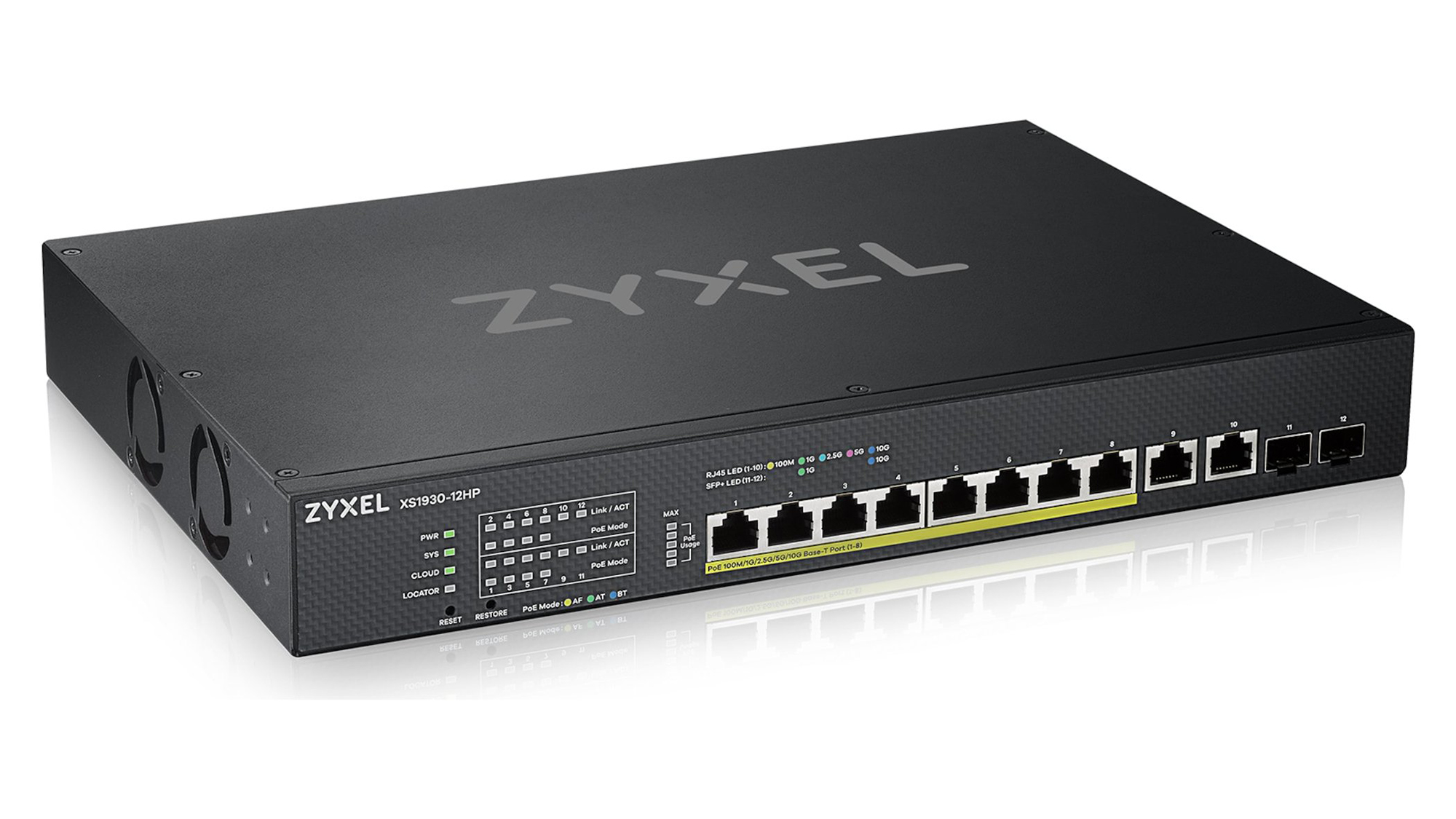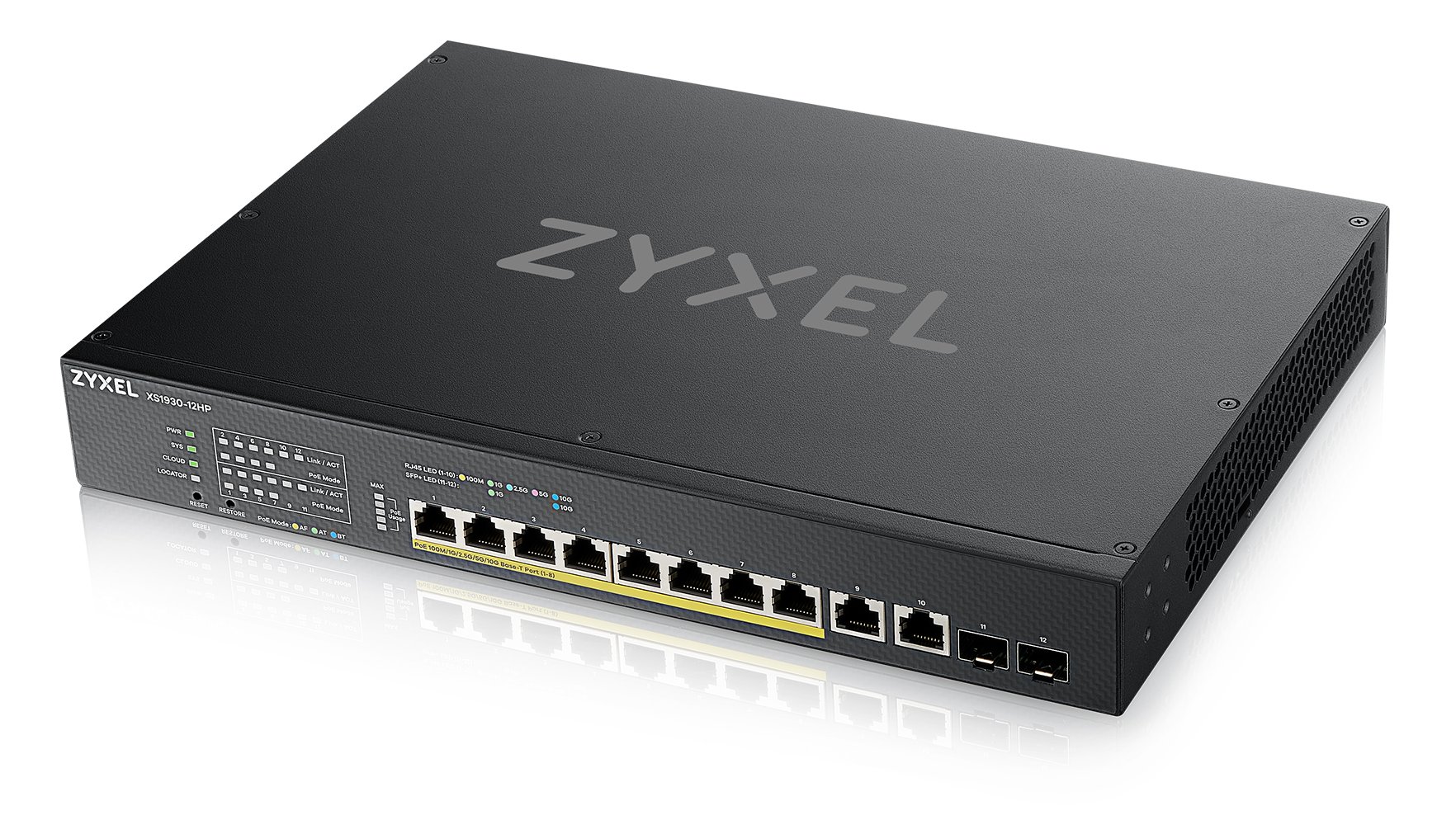Zyxel XS1930-12HP review: In a league of its own
A powerful switch with a network connection for every occasion and powerful PoE++ services


-
+
12 10GbE ports
-
+
375W PoE budget
-
+
Simple, flexible management
-
-
Seven-day network traffic and power consumption graph require NCC Plus license

Zyxel takes multi-gigabit switching to the next performance level with the deceptively small XS1930-12HP, which is positively bulging with features. Not only are all 12 ports on this desktop-sized unit the 10-gigabit (10GbE) variety, but the first eight provide 802.3bt PoE++ services.
The switch is incredibly versatile. All ten copper ports support 100Mbits/sec, 1GbE, 2.5GbE, 5GbE or 10GbE connections and you can easily see their operating speed as each one has a five-colour status LED. The last two are standard 10GbE SFP+ fibre ports for high-speed uplinks over long distances.
A generous power budget of 375W means the switch can easily provide 30W on all eight ports with enough headroom to power quite a few high-performance Wi-Fi 6 access points (APs) that need up to 60W. The LED status panel comes into play again here as it shows which ports are providing power, while a vertical light bar alongside reveals the total draw.
At its foundation, the XS1930-12HP is a Layer 2 (L2) switch with basic Layer 3 routing capabilities. Sometimes referred to as “Layer 3 Lite” or “Advanced L2+”, it supports static IPv4 and IPv6 routing, although not the dynamic routing found in more expensive full Layer 3 switches.
Standard L2 features are plentiful and include port and protocol-based VLANs, QoS traffic prioritisation plus static and LACP link aggregation groups. VoIP networks are covered since the switch identifies traffic from IP phones using their organisationally unique identifier (OUI) and prioritises it automatically by dynamically creating voice VLANs.
Then there’s management. You can opt for standalone mode or use Zyxel’s Nebula Control Center (NCC) platform to move it into the cloud. The local web console fires up a quick-start wizard that insists you change the default admin password and SNMP community name and, although it doesn’t provide any switch graphics, tables offer plenty of detail on system utilisation plus port and PoE usage.

If you’re concerned about exceeding the switch’s power budget, you can set priorities on individual multi-gig ports. Assign one of three priorities to each one and, if the drain reaches the total power threshold, those with the lowest priorities will be switched off first.
Moving the switch to cloud management is a cinch. We used the Nebula iOS app on an iPad to scan its QR code and assign it to our site. A minute later the switch appeared online in our cloud portal, received a firmware update and had configuration access in its local web console disabled.
Selecting the switch from the portal’s monitoring page presents a full status readout and location map, while a multicoloured graphic below shows all active ports, their connection speeds and those delivering power. Graphs are provided for network traffic and power consumption, but if you want more than a rolling 24 hours of data, you’ll need to upgrade the free NCC basic service to a Plus licence, which extends this to seven days.
The portal provides a range of global settings so any switch added to the site automatically receives them. These include QoS profiles, port mirroring and voice VLANs. Security can be stiffened up by limiting all management access to specific host IP address ranges and only allowing the switch to obtain its management address from authorised DHCP servers.
Individual ports on the switch can be configured from NCC, with options for enabling or disabling PoE services and fixing the connection speed, and a Plus licence enabling bandwidth controls. Up to five global PoE schedules can be created and assigned to selected ports so you can decide when powered devices such as wireless APs are active.
Its smart combination of high-performance multi-gigabit ports and generous PoE++ services puts Zyxel’s XS1930-12HP in a league of its own. SMBs that want to deploy the latest Wi-Fi 6 APs and team them with fast links to storage and servers won’t find a better alternative.
Zyxel XS1930-12HP specifications
| Chassis | 1U desktop/rackmount chassis |
| Ports | 12 x 10GbE (10 x multi-gig, 2 x SFP+) Ethernet |
| Total power budget | 375W power budget |
| PoE standard | 802.3at PoE++ on ports 1-8 |
| Backplane capacity | 240Gbits/sec backplane capacity |
| Packet buffer | 2MB packet buffer |
| Total MAC addresses | 16K MAC addresses |
| PSU | Internal PSU |
| Management | Web browser and Nebula management |
| Warranty | Limited lifetime warranty |
| Dimensions | 330 x 230 x 44mm (WDH) |
Get the ITPro daily newsletter
Sign up today and you will receive a free copy of our Future Focus 2025 report - the leading guidance on AI, cybersecurity and other IT challenges as per 700+ senior executives
Dave is an IT consultant and freelance journalist specialising in hands-on reviews of computer networking products covering all market sectors from small businesses to enterprises. Founder of Binary Testing Ltd – the UK’s premier independent network testing laboratory - Dave has over 45 years of experience in the IT industry.
Dave has produced many thousands of in-depth business networking product reviews from his lab which have been reproduced globally. Writing for ITPro and its sister title, PC Pro, he covers all areas of business IT infrastructure, including servers, storage, network security, data protection, cloud, infrastructure and services.
-
 Cleo attack victim list grows as Hertz confirms customer data stolen – and security experts say it won't be the last
Cleo attack victim list grows as Hertz confirms customer data stolen – and security experts say it won't be the lastNews Hertz has confirmed it suffered a data breach as a result of the Cleo zero-day vulnerability in late 2024, with the car rental giant warning that customer data was stolen.
By Ross Kelly Published
-
 Women show more team spirit when it comes to cybersecurity, yet they're still missing out on opportunities
Women show more team spirit when it comes to cybersecurity, yet they're still missing out on opportunitiesNews While they're more likely to believe that responsibility should be shared, women are less likely to get the necessary training
By Emma Woollacott Published
-
 OpenAI wants developers using its new GPT-4.1 models – but how do they compare to Claude and Gemini on coding tasks?
OpenAI wants developers using its new GPT-4.1 models – but how do they compare to Claude and Gemini on coding tasks?News OpenAI says its GPT-4.1 model family offers sizable improvements for coding, but tests show competitors still outperform it in key areas.
By Ross Kelly Published